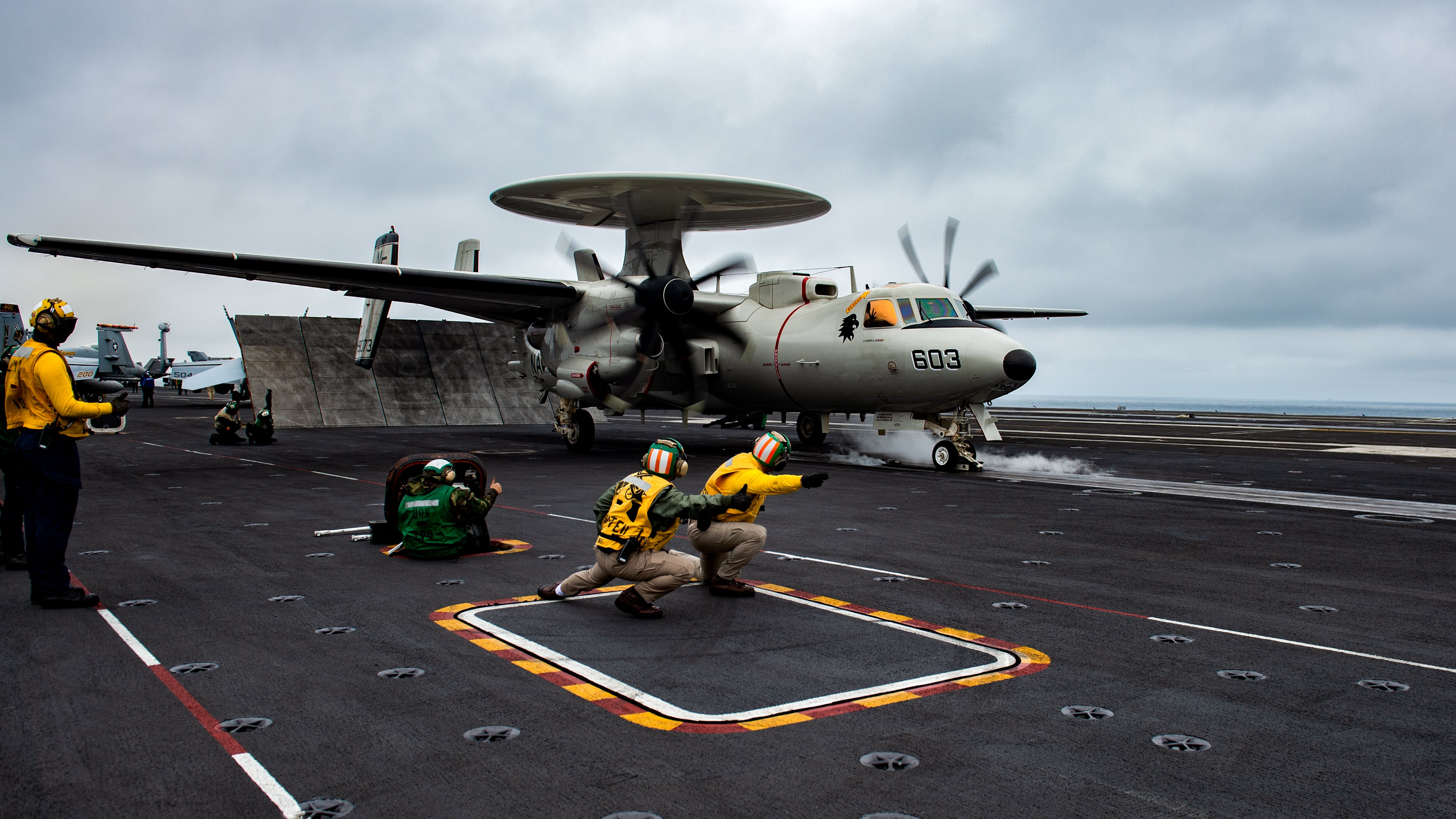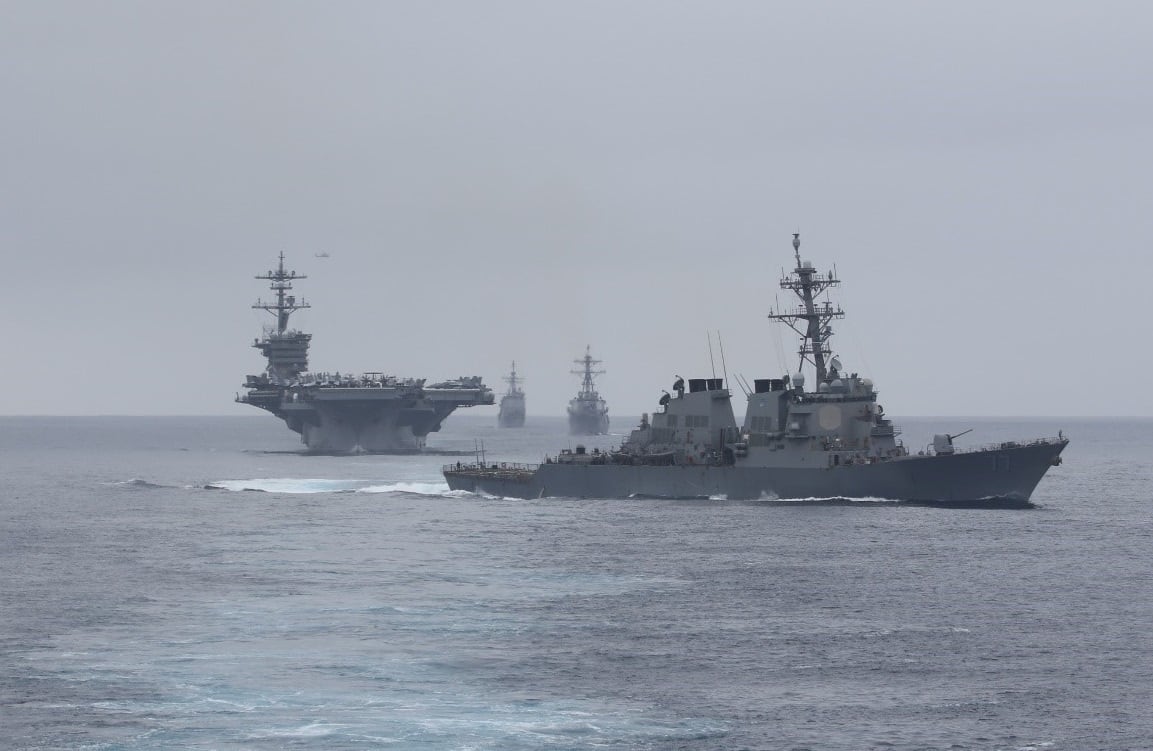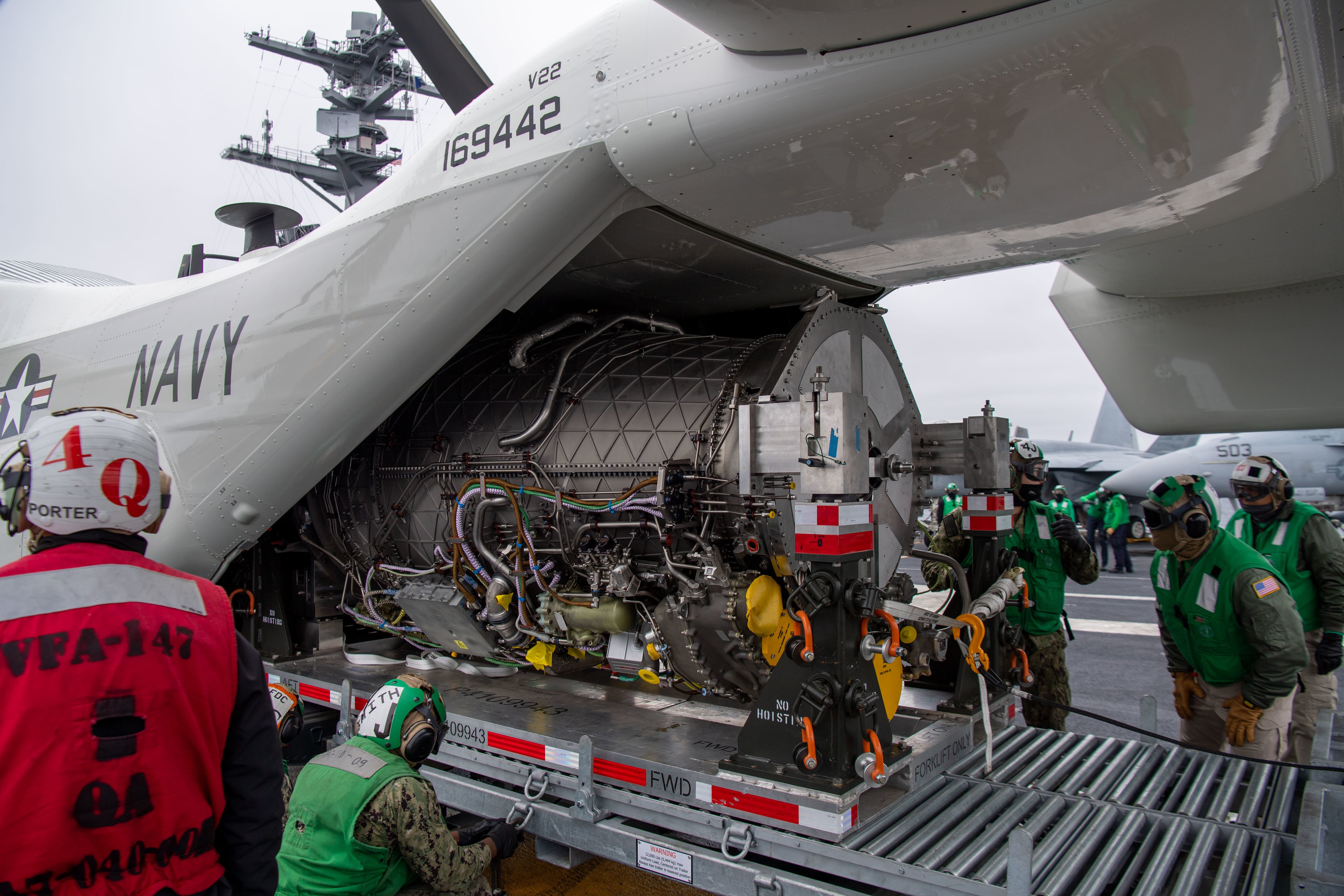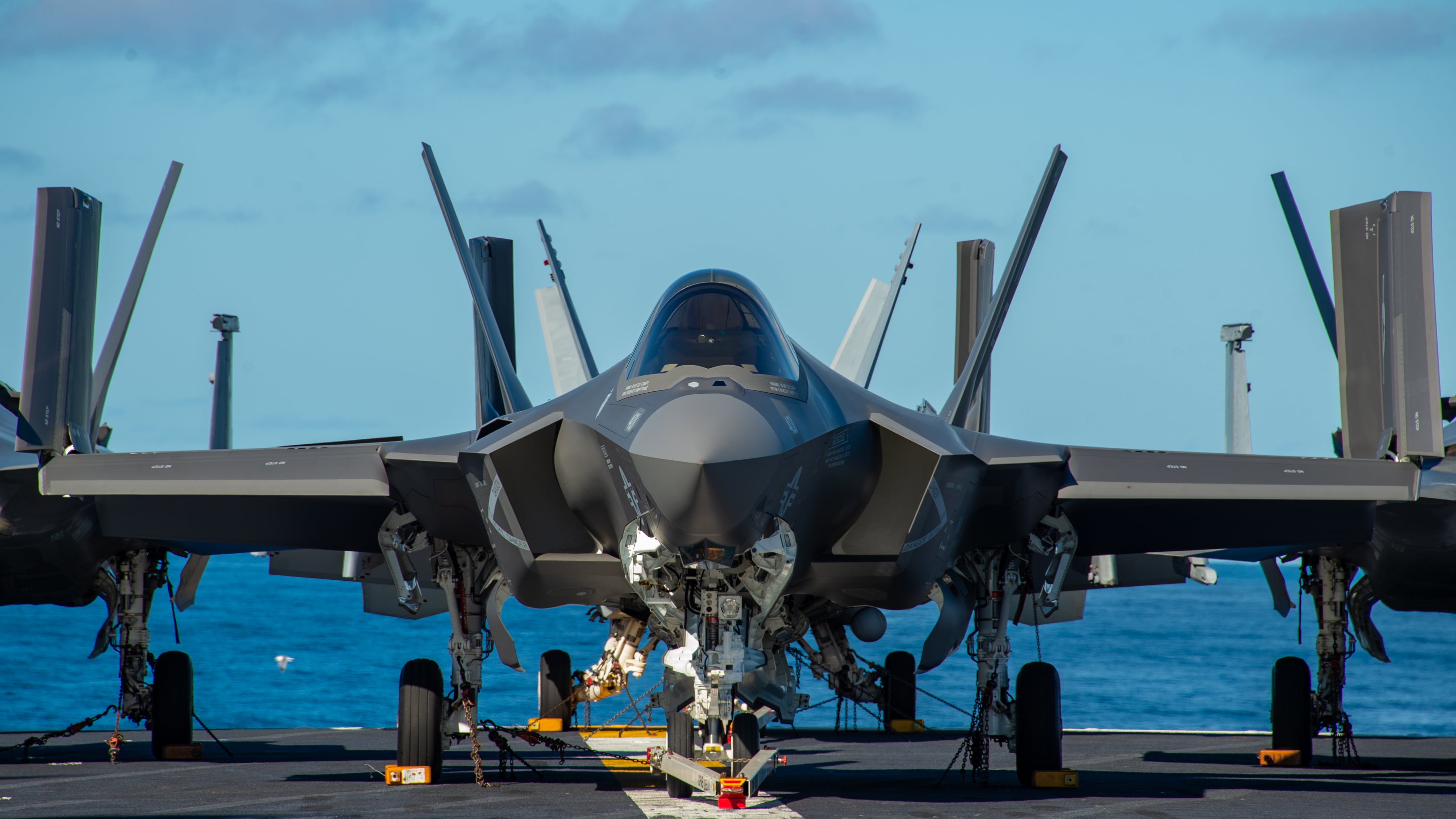WASHINGTON – The air wing the Carl Vinson Carrier Strike Group is hauling around not only includes the F-35C Joint Strike Fighter for the first time in history but also a beefed-up complement of EA-18G Growlers and E-2D Advanced Hawkeyes for an “air wing of the future” leaders think can defeat high-end adversaries before they even spot the U.S. Navy coming.
The Vinson strike group departed San Diego Aug. 2 for a deployment that will likely bring them through the Pacific and into the Middle East.
Though in some ways the deployment will be routine, with the strike group exercising with allies and partners and providing presence in tense areas of the world, the redesigned air wing coupled with the new CMV-22B Osprey logistics airplane is sure to provide the fleet and naval aviation leaders with plenty of lessons learned.
Rear Adm. Dan Martin, the commander of the Vinson strike group, told Defense News in an Aug. 4 interview his strike group is bringing some of the newest F/A-18E-F Super Hornets in the inventory.
“We’ve increased the numbers of aircraft: we’re going to sail with seven EA-18G Growlers [compared to the usual five], 10 F-35s, we’re going to sail with five E-2D Hawkeyes [compared to the usual four],” he said from a call aboard flagship Carl Vinson. “We’re bringing more capability, we’re bringing more quantity, and we figured out just through training and analyzation of our tactics and techniques and procedures that this is the right amount: this is the right amount of air crew, the right amount of airframes.”
Additionally, he said, the strike group went through its final pre-deployment training and certification event with a massive destroyer squadron of eight ships. Only six deployed from San Diego with the carrier, and some will peel off along the way for homeport changes to Japan or will proceed straight to the Middle East ahead of the carrier.
Still, the certification exercise with the advanced carrier air wing and the plussed-up destroyer squadron let the strike group conduct complex operations Martin said were tougher than anything he’d expect to see against a real-world adversary.
During the Air Wing Fallon advanced training this spring at Naval Air Station Fallon, Nev., the air wing had time to take a first crack at learning how to maximize the new configuration, commander Capt. Tommy Locke told Defense News.
“What we found as we went through Air Wing Fallon was the syllabus there allowed us to find ways to go after the entire kill chain of the adversary, which is unique, not something we had been able to do in the past,” he said in an Aug. 3 interview. “We were able to highlight our strengths, but also find some ways we could improve [tactics, techniques and procedures] across the air wing.”

He said the new air wing proved it could bring not just greater lethality to the carrier strike group, but also greater survivability.
“Our EA-18G Growlers are kind of our cornerstone non-kinetic airborne electronic attack for the air wing. We get a couple extra ones with the air wing, which gives us a little more capacity to be able to spread that capability across,” Locke said.
That extra electronic warfare capacity from the two additional Growlers in the air wing, combined with the additional E-2D for greater in-air command and control and the new stealth and advanced sensing from the F-35C, he said, keeps the whole strike group safe by “getting ahead of the threat’s ability to gain information on us early on” by finding and destroying enemy sensors, networks and shooters before they can see the strike group coming.
“You really get a formidable force to go after” threats in open waters and in the littoral environment, he said.
Though the air wing had its best opportunity to develop and mature these tactics for high-end operations during Air Wing Fallon – held at a sophisticated training range – Locke said the deployment would present new learning opportunities.
First, the air wing can practice some tactics in smaller controlled areas the strike group can set up during the deployment. Second, the air wing can work with allies who also bought the F-35, integrating at the coalition level and sharing best practices. And third, he said, the air wing can learn how to contribute to other warfare commanders in the strike group and leverage their assets. Locke said the air wing didn’t get to train with the strike group’s destroyer squadron or information warfare commander until the final certification exercise, meaning there’s plenty more work to be done to integrate and maximize each other’s capabilities.

Capt. P. Scott Miller, Vinson’s commanding officer, said in a separate Aug. 4 interview the new F-35C maneuvers around the carrier and in its local air space naturally – but he said the ship has had to work hard to support the larger overall air wing.
With 67 planes in the air wing and three CMV-22s coming and going from their shore-based hubs, the ship needed to clear out more space on the deck and in the hangar.
“We give a lot of attention to the F-35,” he said, but “the behind-the-scenes increase in the number of EA-18G Growlers, two more of those, and one more E-2 has really been what’s filled up the inside and the topside of the ship. And to prepare for that, we’ve paid particular attention to what other support equipment we have on board, and we’ve slimmed down or leaned down the things that we would have on board that are a bit for crew comfort. If you were on an aircraft carrier five, seven years ago, you’d see a lot of treadmills and exercise equipment kind of littering the edges of the space.”
“Those are all gone now; we’re to mission-essential items only as we learn how to operate with this higher operational density,” Miller continued.
The ship also has to support the CMV-22B for the first time, which replaces the aging C-2A Greyhound as the carrier onboard delivery (COD) aircraft that brings people, parts and mail from the shore to the strike group at sea. The C-2A was already aging and in need of eventual replacement, but the V-22 variant was picked because of its ability to carry the large F-35 engine – something the C-2 or an updated derivative of it couldn’t do. The F-35 and the V-22 are coupled together in the naval services, with the F-35 unable to deploy on carriers or amphibious ships without the V-22 nearby to fly on a replacement engine if needed.
Miller said the Navy as a whole knows how to operate the V-22 due to the Marine Corps’ extensive use of the aircraft, but incorporating the tiltrotor aircraft – which sometimes flies like a plane and sometimes flies like a helicopter – into the carrier landing pattern has been an adjustment.
“It’s not a fixed-wing airplane, so it doesn’t land with the normal aircraft in the normal way that the C-2 did,” he said. “Once it gets within very close range of the aircraft carrier, it operates a little bit more like a helicopter, in its vertical landings and [short takeoffs].”
“So instead of landing with the fixed wing, it lands with a rotary wing,” Miller added. “We’re learning how to operate that, we think we’ve pretty much figured that out.”

Despite working through a few kinks in incorporating the tiltrotor into flight deck operations, Miller said the V-22 opens up a lot of possibilities for the carrier strike group. For example, the C-2 is limited to daylight operations, whereas the V-22 is certified to operate at night. While the carrier isn’t using the V-22 to send passengers to and from the carrier at night, it has been using the tiltrotor to bring supplies at night, which “has been a huge addition for us in our ability to continue doing the mission.”
Leading up to the deployment, Miller said, the carrier’s flight deck crew and aviation maintenance crew had to work through a range of scenarios with the V-22: What if the aircraft experienced a malfunction and came in for an emergency landing? How would the crew tow the much-larger V-22 around the flight deck and down to the hangar bay? Can the ship’s aviation mechanics fix a range of potential casualties the V-22 could experience that would keep it from flying off the carrier and back to its hub ashore?
Even if the V-22 is operating as a logistics aircraft in the carrier strike group rather than a warfighting aircraft, Miller said its inclusion in the carrier strike group is making everyone safer.
“I would say as an air wing, to include the carrier onboard delivery, we were able to more confidently operate tactically and safely at a further distance from land than I’ve seen in my career,” said Miller, a career pilot. “If we get to choose where we want to operate from, that gives us a significant tactical advantage in whatever environment we might find ourselves in.”
He noted that, while the carrier wants to operate farther from enemy shores and outside the range of enemy missiles, the carrier strike group can only operate in areas where it can sustain itself. The longer legs on the V-22 “allow us to operate at those ranges that I hadn’t seen before.”

Though the strike group leadership declined to discuss future operational plans, they said their first mission, after recertifying the air wing, will be participating in the global Large Scale Exercise the Navy is hosting for two weeks, using live, virtual and constructive (LVC) participants to simulate a global warfighting effort.
Martin, the carrier strike group commander, said that, after recently going through a high-end certification exercise, “we’re feeling like we’re bringing a good game to the exercise” and have a lot to contribute to the live portion.
“We’re ready to help this exercise refine how we synchronize maritime operations across multiple fleets in support of the joint force, and we’re excited to participate,” he said.
Megan Eckstein is the naval warfare reporter at Defense News. She has covered military news since 2009, with a focus on U.S. Navy and Marine Corps operations, acquisition programs and budgets. She has reported from four geographic fleets and is happiest when she’s filing stories from a ship. Megan is a University of Maryland alumna.





